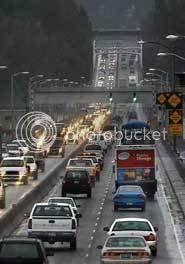Blog Crunch Time Aproaches On SR 520 Bridge Replacement
The Washington State Department Of Transportation authorized a preliminary consultant inquiry – recently completed – into the feasibility of a tunnel to replace the congested, dangerously earthquake-prone and windstorm-prone State Route 520 Floating Bridge across Lake Washington from Seattle to the Eastside. It’s one of just two bridges across the 22-mile long lake, and the jammed, 60s-vintage four-laner carries 155,000 to 160,000 people per day.  The odds-on favorite to replace it is……a new, wider and safer floating bridge. However, well-heeled communities at both ends have strong concerns about bridge-related noise and air pollution, and on the Seattle side, about current roadway impacts on the Washington Park Arboretum. These concerns could translate into expensive mitigation measures attached to a new bridge, or absent that, litigation driving up the current WSDOT cost estimate of $3.9 to $4.38 billion. Due to their environmental concerns, community leaders in affected Seattle neighborhoods are looking favorably upon a tunnel for the sensitive western approach to any new bridge, as the Seattle Post-Intelligencer’s Debera Carlton Harrell reported in late October.
The odds-on favorite to replace it is……a new, wider and safer floating bridge. However, well-heeled communities at both ends have strong concerns about bridge-related noise and air pollution, and on the Seattle side, about current roadway impacts on the Washington Park Arboretum. These concerns could translate into expensive mitigation measures attached to a new bridge, or absent that, litigation driving up the current WSDOT cost estimate of $3.9 to $4.38 billion. Due to their environmental concerns, community leaders in affected Seattle neighborhoods are looking favorably upon a tunnel for the sensitive western approach to any new bridge, as the Seattle Post-Intelligencer’s Debera Carlton Harrell reported in late October.
A bill passed by the state legislature includes funding for consultants to examine a western approach tunnel, a combination of tunnels and submerged tubes under the lake, and moving SR 520 out of the way of the arboretum. It also stipulates that any replacement of The Bridge Of 1,000 Sorrows (left) would have to include two general purpose and one carpool (HOV) lane in each direction, with the carpool lanes being capable of accomodating high-capacity transit. In a preliminary report to the legislatively-mandated SR 520 mediation committee, Casper Paludan-Muller of COWI Denmark found that “a floating tunnel anchored by stays, could be feasible” as a replacement for the current bridge. Paludan-Muller noted there is “no experience in the world yet” to support the floating tunnel concept and “further investigation is needed to reduce the risks.” This would have to include an up-to-date assessment of earthquake resistance technology for floating tunnels, and associated construction costs. The COWI report notes that an immersed tunnel installed below the lake’s bottom – something with which the firm has extensive global design experience – is another possibility, but would require a pile foundation due to Lake Washington’s depth.
Paludan-Muller also reported that a tunnel solely for the western approach, which would lead into a replacement floating bridge, would be three to four times more expensive than building a widened western approach above ground.
No cost magnitude was given in the report for any kind of cross-lake tunnel, and certainly, any such endeavor would require community support and a financing plan which controls general taxpayer costs, in part through tolling, and perhaps also union pension fund or private infrastructure fund investment. The same financing tools will be important to consider even if a replacement floating bridge is chosen. Available revenues identified by WSDOT now exceed 50 percent of the estimated cost range only if tolling yet to be approved by legislators is included.
Far from a Seattle-centric concern, SR 520 is a crucial regional corridor linking Seattle to the jobs-rich Eastside; and connecting points east, southeast and northeast to the University of Washington in Seattle, a large regional employer and nationally-recognized educational and research institution. Following the rejection by voters Nov. 6 of the roads and transit ballot measure Proposition One, impetus is building for new approaches to transportation planning and funding.
The COWI report helps move the ball down the field, but we need to pick up the pace on SR 520 decision-making. Construction is not scheduled to start until 2012. With the bridge at risk of collapsing in an earthquake or severe windstorm – and taking a horrific toll on human life, and our civic reputation – that’s simply too long. Yet doing it sooner also necessitates working even harder to ensure we have the best information, and the best design and finance plan for the replacement structure(s).
SR 520 decision-makers and the public will need to have the most realistic estimates of the full project costs – including environmental mitigation – of an immersed tunnel spanning the lake, a floating tunnel across the lake, a replacement floating bridge across the lake, and a tunnel versus a new above-surface structure for the western approach. Then, whichever options are selected, our region’s and state’s putative leaders will have to find innovative ways to raise the needed funds, making sure they don’t try to soak wary taxpayers.
TECHNORATI TAGS: <a href="http://technorati.com/tag/SEATTLE, EASTSIDE, WASHINGTON STATE, STATE ROUTE 520 FLOATING BRIDGE, SAFETY, EARTHQUAKE, WINDSTORM, REPLACEMENT BRIDGE, FLOATING TUNNEL, IMMERSED TUNNEL, COWI "rel="tag"SEATTLE, EASTSIDE, WASHINGTON STATE, STATE ROUTE 520 FLOATING BRIDGE, SAFETY, EARTHQUAKE, WINDSTORM, REPLACEMENT BRIDGE, FLOATING TUNNEL, IMMERSED TUNNEL, COWI
